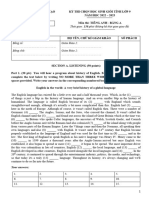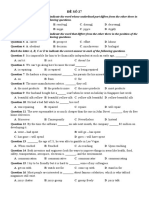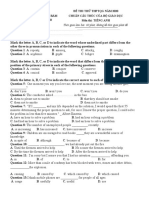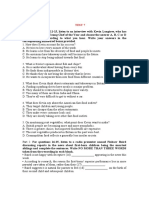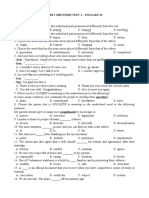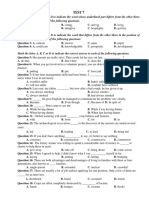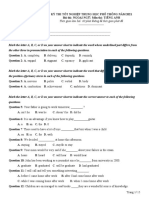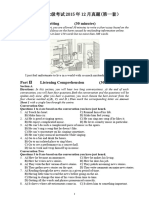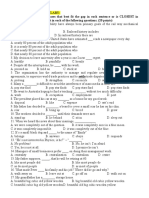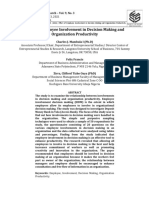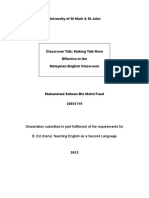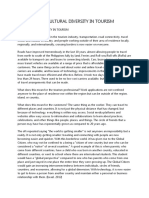Test-5 2
Uploaded by
jisxie.tdTest-5 2
Uploaded by
jisxie.tdTEST 5
FULL NAME: _____________________________________________SCORE:__________________
SECTION A: LISTENING
Part 1. (30 pts) You will hear a program about history of English. For questions 1-15, listen and
complete the text below by writing NO MORE THAN ONE WORD/OR A NUMBER in the spaces
provided. Write your answers in the corresponding numbered boxes provided.
English in the world: A very brief history of a global language
The English language has existed for a little over one and a half thousand years. Which, in the (1) ________
of things is just a blip in the history of human language. And an even smaller blip in the history of humankind.
The language is English because of its (2) ________ with England which sounds straightforward enough,
although it's actually a bit more complicated than this. English had (3) ________ here in the of Europe.
Although of course, it wasn't called English then. There were a number of Germanic (4) ________ The
Angles, Saxons, and the Jutes, who crossed the channel; It wasn't called the English channel until the (5)
________ and found out across the island of Great Britain which at the time was (6) ________ by Britons
who spoke Celtic languages, the ancestors of Welsh, Scottish Gaelic, and Cornish before the Anglo-Saxons
arrived the Romans had also colonised (7) ________ of the island along with people from various parts of
the Roman Empire. Later the Vikings came and then the Normans, all speaking their own languages and also
(8) ________ with English. It wasn't until the 14th century that English became properly established as the
language of England and was used for the first time in (9) ________ and in the law. The first king of
England to speak English as his native language was Henry IV. Henry came to the (10) ________ in 1399
almost a thousand years after the Anglo-Saxons arrived but once English was established, it also began to
spread or more (11) ________ it began to be spread. The most important driver for this was colonialism in
lots of countries, English (12) ________ the local language, and (13) ________ of English developed in
other countries, English existed alongside the local languages and (14) ________ . In the 20th century, it
continued to spread thorough the entertainment industry, politics, the media, and technology, so that today
it's a (15) ________ language. Throughout its history, it's always changing and we'll continue to do so far
into the future.
YOUR ANSWERS:
1. 2. 3. 4. 5.
6. 7. 8. 9. 10.
11. 12. 13. 14. 15.
Part 2. (10 pts) You will hear an interview with a man called Tony Elliott who founded a magazine
called Time Out. For questions 1-10, decide whether the following statements are true (T) or false (F).
Write your answers in the corresponding numbered boxes provided.
1. Time Out was unlike other publications in 1968 because it had a comprehensive list of events.
2. They were idealistic amateurs from the start.
3. Tony did not have any publishing experience.
4. Tony promptly transformed Time Out into being a kind of contemporary arts magazine.
5. Tony left the university because he had found an alternative career.
Page 1 of 13
6. At first, the magazine was three-weekly.
7. According to Tony, it was external pressure that led the magazine to become weekly.
8. Some people started the same publication.
9. Big publishers were not interested in this type of magazine.
10. The readership have become older.
YOUR ANSWERS:
1. 2. 3. 4. 5.
6. 7. 8. 9. 10.
Part 3. (10 pts) You will hear a news report about eco-homes. For questions 1-5, choose the correct
answer (A, B or C) which fits best according to what you hear. Write your answers in the
corresponding numbered boxes provided.
1. What is the best headline for this story?
A. Eco-home residents see energy bills soar.
B. Government pledges to construct more eco homes.
C. Eco-home construction delayed by financial problems.
2. Which of the following is NOT true of the Pavilion Gardens complex?
A. It was finished two years ago.
B. It comprises 45 homes.
C. It cost 6.5 million pounds to build.
3. James Farmer's energy bill was
A. £900 for 3 months
B. £1600 for 3 months
C. £1500 for 6 months
4. Bradford Council will
A. demand that the energy company reduces the bills
B. find out why the bills are so high and try to lower them
C. find alternative accommodation for the people of Pavilion Gardens
5. The critic disagrees with the government's pledge to build more eco-homes because
A. the homes are poorly designed
B. the homes are too expensive to build
C. the homes do not significantly cut energy use
YOUR ANSWERS:
1. 2. 3. 4. 5.
SECTION B. LEXICO-GRAMMAR (20 points)
Part 1. (12 pts) Choose the best answer to complete each of the following sentences. Write A, B, C or
D in the corresponding numbered boxes provided.
1. The boy who failed the exam has to take another one, _______?
A. did he B. hasn't he C. didn't he D. doesn't he
Page 2 of 13
2. This clock is always slow; I put it _______ ten minutes every morning.
A. back B. up C. forward D. ahead
3. In my small house there are two rooms, _______ is used as the living-room.
A. the large one B. the largest one C. the largest of which D. the larger of which
4. Before the invention of the Internet, people couldn't¸ _______ of such universal access to information.
The main way to update it at that time was to read newspaper.
A. Approach B. conceive C. Reminisce D. Contemplate
5. Parents should protect children from getting into trouble in their early teens or else they will go on to
become _______ offenders.
A. Relentless B. insistent C. persistent D. consistent
6. _______ 90 percent of Asia's people live in the eastern and southern parts of the continent, which
contain some of the most regions in the world.
A. Most/thick-populated B. Most/thickly-populated
C. Almost/thick-populated D. Almost/thickly-populated
7. Most psychologists believe that the basic structure of an individual's personality is _______.
A. well established extremely by the age of five
B. by the age of five it is extremely well established
C. by the age of five and well established extremely
D. extremely well established by the age of five
8. There are _______ words in English having more than one meaning. Pay close attention to this fact.
A. a large many B. quite many C. a great many D. quite a lot
9. The contractor's recommendation is that the old building _______.
A. need repairing B. is needed repairing
C. needs to be repaired D. need to repair
10. Choose the correct answer A, B, C, or D to indicate the word CLOSEST in meaning to the
underlined bold word in the following question.
Children who know how to tend a garden can grow up to be environmentally conscious individuals.
A. conduce B. care C. trend D. destroy
11. Choose the correct answer A, B, C, or D to indicate the words OPPOSITE in meaning to the
underlined bold words in the following question.
After having a poor performance in the mid-term test, I decided to put my shoulder to the wheel to
achieve better results in the final test.
A. refuse to work hard B. pay much attention
C. keep anxious D. work diligently
12. Choose the correct answer A, B, C, or D to indicate the most suitable response to complete the
following exchange.
Brian and Robert are discussing the topic of nutrition.
- Brian: "People should eat five daily portions of fruit and vegetables, as far as I'm concerned."
- Robert: " ______ since fruit and vegetables are packed with essential vitamins, minerals and fiber"
A. I shouldn't agree with you more B. That's just what I am thinking
C. I'm not so sure about that D. I must take issue with you on that
Page 3 of 13
YOUR ANSWERS:
1. 2. 3. 4.
5. 6. 7. 8.
9. 10. 11. 12.
Part 2. (8 pts) Read the passage below, which contains 8 mistakes. Identify the mistakes and write
the corrections in the corresponding numbered boxes provided.
Line
1 Thousands of books have written on the conflict between parents and teenagers. Psychologists and
2 sociologists have spent years to try to understand the reasons for the tension and endless arguments between
3 these two groups.
4 A close look at these arguments often reveals that the reasons are so trivial that we may wonder how the
5 tears and shouts have all been about. Most arguments are not about major issues like the nuclear bomb or
6 the ecological problems of the universe. The fights are usually about simply matters such as food, clothes,
7 the weekly allowance or the telephone.
8 Let's take an ordinary day and examine what happens. Problems start around 7 a.m. It is then when parents
9 expect their children to get up, get dressed, eat and go to school. Parents and alarm clocks seem like the
10 enemy of mankind at that early hour. Some parents even expect the "poor" youngsters to tidy up their room
11 and put everything in its place before leave for school - a ridiculous demand - in the eyes of the "victims".
12 In the afternoon, parents want them to do homework and study hard.
13 They resent their children's endless conversations on the phone. In the evening, they complain about the
14 clothes and jewelry the teenagers wear and preach for hours about the dangers on the road and the need to
15 be home by midnight in the latest, like Cinderella
YOUR ANSWERS:
Line Mistake Correction Line Mistake Correction
1. 6.
2. 7.
3. 8.
4. 9.
5. 10.
Page 4 of 13
SECTION C. READING (70 points)
Part 1. (15 pts) Read the passage and choose the best answer. Write your answers A, B, C or D in the
corresponding numbered boxes provided.
Many educators believe that it is better for students to attend school all year round than to have a long
summer vacation. Ideally, the summer can be (1) _______. bit as productive as time (2) _______ in a
classroom. The vacation should be a carefree time, spent outdoors or with family but, (3) _______ that
most parents work, it is all too often the case that children are left unsupervised. All students forget a
certain (4) _______ of what they have learned so teachers are (5) _______ to spend time at the beginning
of the year reviewing parts of the curriculum from the previous grade. Studies have shown that children
from low-income families fall (6) _______ behind during the summer than children from wealthier
backgrounds. One study found that (7) _______ middle-class children slightly improved their reading
skills over the summer months, their (8) _______ from low-income families lost more than two months in
reading achievement. (9) _______ solve the problem, some school districts have (10)
a year-round schedule with a series of shorter breaks instead of a three-month summer vacation. A national
study carried out by the Ohio State University found, however, that year round schools had no significant
impact (11) _______ how much children learn. They found that children learned about as much in year-
round schools as they did in schools using a nine-month calendar.b And while poorer students at the (12),
_______ did suffer "learning loss" during the summer months, (13) _______ at the year-round schools also
did (14) during the shorter breaks. The author of the study suggested that poor children need to attend more
days of school, (15) _______ they will fall behind.
1. A. every B. almost C. nearly D. any
2. A. attending B. spent C. is D. passes
3. A. when B. besides C. consequently D. given
4. A. minority B. touch C. amount D. number
5. A. going B. mandatory C. obliged D. compulsory
6. A. much B. further C. even D. lot
7. A. while B. yet C. fewer D. rather
8. A. students B. peers C. assignments D. courses
9. A. Hence B. Seeing that C. In order to D. On account of
10. A. adopted B. covered C. opted D. required
11. A. to B. with C. on D. towards
12. A. others B. latter C. beginning D. study
13. A. those B. all C. former D. they
14. A. likely B. so C. this D. such
15. A. after B. therefore C. otherwise D. Unless
YOUR ANSWERS:
1. 2. 3. 4. 5.
6. 7. 8. 9. 10.
11. 12. 13. 14. 15.
Page 5 of 13
Part 2. (15 pts) Read the text below and fill in each gap with ONE suitable word. Write the answers
in the corresponding numbered boxes provided.
Can Listening to Music Help You Concentrate?
Are you the kind of person (1) _______ enjoys listening to music when (2) _______ out certain tasks – for
instance, while studying (3) _______ an exam, driving a car, or reading a book? A common belief shared
by many is that listening to background music helps improve focus, blocks (4) _______ distractions, and
even makes a tedious task more enjoyable. Yet (5) _______ the prevalence of music in our daily lives, (6)
_______ is known about how this soundtrack affects brain function. A recently published article in
"Psychomusicology: Music, Mind, and Brain" examined the effects of background music (7) _______
memory by using music to alter the listener's (8) _______(happy or sad) and arousal states (positive or
negative).
The results? It turns out memory performance was best (9) _______ listening to low arousal, negative music,
and (10) _______ for high arousal negative music. However, (11) _______ to silence, background music
had (12) _______ no effect for some participants or significantly impeded memory performance. It turns
out some people use (13) _______ same mental processes which are required to remember things to also
process music, which (14) _______ that a percentage of the brain regions responsible for memory - regions
you need to focus on the task at (15) _______ - are actually being re-allocated to processing background
noise.
YOUR ANSWERS:
1. 2. 3. 4. 5.
6. 7. 8. 9. 10.
11. 12. 13. 14. 15.
Part 3. (20 pts) Read the following passage and choose the correct answer to each of the questions.
Write your answers A, B, C or D in the corresponding numbered boxes provided.
Personality and health
There is increasing evidence that health is linked to personality. However, until now, the relationship has not
affected the way health care is delivered. There are several reasons for this. Some health workers doubt
whether there is a direct link between health and personality or whether it's just a coincidence. Some feel it
is their professional duty to treat all patients in the same way. Others argue that delivering health services
according to patients' personalities will have minimal impact and therefore isn't worth the effort. However,
some psychologists believe that applying different procedures to people with different personalities could
have a significant, positive effect on health.
Research into personality has, in recent years, focused on the Big Five model of personality types. This
model measures how neurotic, extrovert, open to experience, agreeable and conscientious a person is. Some
of these personality types have been studied in relation to health. For example, conscientious people tend to
Page 6 of 13
be less likely to smoke, drink too much alcohol or be inactive. However, in other cases, the relationship is
less clear. Neurotic behaviour, for instance, has been found in some studies to increase the risk of death, in
others to protect people from illness and in others to have no link to health at all.
Even so, if health workers applied an understanding of personality to the services they provide, they could
influence the extent to which patients act on advice and follow their treatment. For example, high sensation-
seeking individuals, who are extroverts and unconscientious in the Big Five model and tend to take part in
risky activities, respond to drama, energy and emotion. Thus, to encourage those people to follow health
advice, health promotions can be designed to incorporate those factors. An example of this was the campaign
SENTAR which aimed to reduce cannabis use among high sensation-seeking teenagers. By creating asuitable
television advert, they successfully engaged these youths and reduced their recreational drug use. Of course,
this approach isn't always possible. It is often impractical and expensive to create several versions of a
campaign to reach different personality types. However, recent developments in computer technology,
cookies and targeted advertising may allow this approach to be used more in future.
Personality could also be considered when sending messages, information and guidance to specific patients.
Already, health information is usually available in various forms-printed, digital, audio, and so on - to be
suitable and accessible for different users, such as the blind, the elderly, and people with reading difficulties.
Research has also shown that, by identifying different patients' motivations for treatment and then
corresponding with them in a way that reflects their motivations, patients will become more involved in their
treatment, compared to when the same messages are sent to everyone. Correspondence could, therefore, be
adapted to reflect patients' personality type, too. For example, less conscientious people could be sent phone
reminders to attend appointments. So far, there has been very little research into the effectiveness of tailoring
health guidance according to personality, so this area deserves further study.
Until now, the focus of personality -- health research has been to explore the link between personality and
health and has had very little practical application. Thus, health workers have not engaged deeply with it.
However, by suggesting, trialing and implementing practices to engage patients with different
personalities, the relationship between psychology researchers and health workers could improve, along
with the health of the general public.
1. Who is the article most likely aimed at?
A. psychologists B. patients at a clinic
C. neurotic people D. health workers outside psychology
2. What is the main idea of the article?
Research into the link between Health and Personality __________
A. has shown that sensation-seeking individuals often risk their health.
B. should be carried out by both clinicians and psychologists.
C. has not been studied in great depth until recently.
D. can be practically applied to improve public health.
3. Which of these is NOT a reason why clinicians do not currently consider personality in their approach to
healthcare?
Page 7 of 13
A. They consider it their duty to treat all patients equally.
B. They think the effect on a patient's health will be hardly noticeable.
C. They lack sufficient training in psychology.
D. They doubt whether a person's personality directly affects their health.
4. The word "they" in paragraph 3 refers to ________.
A. understanding of personality B. patients C. health workers D. Services
5. What can be concluded from the text about neurotic patients?
A. They are at greater risk from early death than non-neurotic patients.
B. There is no consistent link between a patient's level of neurosis and their health.
C. Their neurosis protects them from becoming sick.
D. They are more likely than non-neurotic patients to report illness.
6. It can be inferred that the campaign SENTAR ________.
A. used drama and energy in its design.
B. failed to reduce cannabis use among teenagers.
C. was designed to attract conscientious, high sensation-seeking teenagers.
D. was delivered across multiple media, including television and online.
7. The writer believes that improving computer technology ________.
A. will affect the number of high sensation-seeking people in the population.
B. can help psychologists better understand the link between personality and health.
C. will ensure that more people are aware of public health campaigns.
D. can help health workers deliver appropriate messages to different types of people.
8. The word "recreational" in paragraph 3 most nearly means
A. enjoyable B. amusing C. stimulating D. Comical
9. In paragraph 4, the writer refers to a study that found that ________.
A. phone reminders ensure that unconscientious patients attend appointments.
B. adapting letter-writing style can encourage patients with different goals to participate.
C. information in audio form helps blind people to access health information.
D. adapting correspondence to suit different personalities can have a positive impact on health.
10. In the final paragraph, what does the writer advise researchers in health/personality to do?
A. Talk directly to the general public.
B. Explore the link between personality and health.
C. Give more practical suggestions to health workers.
D. Do more research before giving advice to health workers.
YOUR ANSWERS:
1. 2. 3. 4. 5.
6. 7. 8. 9. 10.
Part 4. (20 pts) Read the following passage and do the tasks that follow.
Page 8 of 13
Follow your nose
A. Aromatherapy is the most widely used complementary therapy in the National Health Service, and doctors
use it most often for treating dementia. For elderly patients who have difficulty interacting verbally, and to
whom conventional medicine has little to offer, aromatherapy can bring benefits in terms of better sleep,
improved motivation, and less disturbed behaviour. So the thinking goes. But last year, a systematic review
of health care databases found almost no evidence that aromatherapy is effective in the treatment of dementia.
Other findings suggest that aromatherapy works only if you believe it will. In fact, the only research that has
unequivocally shown it to have an effect has been carried out on animals.
B. Behavioural studies have consistently shown that odours elicit emotional memories far more readily than
other sensory cues. And earlier this year, Rachel Herz, of Brown University in Providence, Rhode Island,
and colleagues peered into people's heads using functional Magnetic Resonance Imaging (fMRI) to
corroborate that. They scanned the brains of five women while they either looked at a photo of a bottle of
perfume that evoked a pleasant memory for them, or smelled that perfume. One woman, for instance,
remembered how as a child living in Paris - she would watch with excitement as her mother dressed to go
out and sprayed herself with that perfume. The women themselves described the perfume as far more
evocative than the photo, and Herz and co-workers found that the scent did indeed activate the amygdala and
other brain regions associated with emotion processing far more strongly than the photograph. But the
interesting thing was that the memory itself was no better recalled by the odour than by the picture. "People
don't remember any more detail or with any more clarity when the memory is recalled with an odour," she
says. "However, with the odour, you have this intense emotional feeling that's really visceral."
C. That's hardly surprising, Herz thinks, given how the brain has evolved. "The way I like to think about it
is that emotion and olfaction are essentially the same things," she says. "The part of the brain that controls
emotion literally grew out of the part of the brain that controls smell." That, she says, probably explains why
memories for odours that are associated with intense emotions are so strongly entrenched in us, because the
smell was initially a survival skill: a signal to approach or to avoid.
D. Eric Vermetten, a psychiatrist at the University of Utrecht in the Netherlands, says that doctors have long
known about the potential of smells to act as traumatic reminders, but the evidence has been largely
anecdotal. Last year, he and others set out to document it by describing three cases of post-traumatic stress
disorder (PTSD) in which patients reported either that a certain smell triggered their flashbacks, or that smell
was a feature of the flashback itself. The researchers concluded that odours could be made use of in exposure
therapy, or for reconditioning patients' fear responses.
E. After Vermetten presented his findings at a conference, doctors in the audience told him how they had
turned this association around and put it to good use. PTSD patients often undergo group therapy, but the
therapy itself can expose them to traumatic reminders. "Some clinicians put a strip of vanilla or a strong.
pleasant, everyday odorant such as coffee under their patients' noses, so that they have this continuous
olfactory stimulation," says Vermetten. So armed, the patients seem to be better protected against flashbacks.
It's purely anecdotal, and nobody knows what's happening in the brain, says Vermetten, but it's possible that
the neural pathways by which the odour elicits the pleasant, everyday memory override the fear-conditioned
Page 9 of 13
neural pathways that respond to verbal cues.
F. According to Herz, the therapeutic potential of odours could lie in their very unreliability. She has shown
with her perfume-bottle experiment that they don't guarantee any better recall, even if the memories they
elicit feel more real. And there's plenty of research to show that our noses can be tricked, because being
predominantly visual and verbal creatures, we put more faith in those other modalities. In 2001, for instance,
Gil Morrot, of the National Institute for Agronomic Research in Montpellier, tricked 54 oenology students
by secretly colouring a white wine with an odourless red dye just before they were asked to describe the
odours of a range of red and white wines. The students described the coloured wine using terms typically
reserved for red wines. What's more, just like experts, they used terms alluding to the wine's redness and
darkness-visual rather than olfactory qualities. Smell, the researchers concluded, cannot be separated from
the other senses.
G. Last July, Jay Gottfried and Ray Dolan of the Wellcome Department of Imaging Neuroscience in London
took that research a step further when they tested people's response times in naming an odour, either when
presented with an image that was associated with the odour or one that was not. So, they asked them to sniff
vanilla and simultaneously showed them either a picture of ice cream or of cheese, while scanning their
brains in a fMRI machine. People named the smells faster when the picture showed something semantically
related to them, and when that happened, a structure called the hippocampus was strongly activated. The
researchers' interpretation was that the hippocampus plays a role in integrating information from the senses-
information that the brain then uses to decide what it is perceiving.
Questions 1-6
The reading passage has seven paragraphs, A-G. Choose the most suitable heading for paragraphs A-
G from the list of headings below. Write the appropriate numbers (i-ix) in the corresponding
numbered boxes provided. (0) has been done for you. Please note that there are more headings than
you can use.
List of Headings
i. Remembering the past more clearly
ii. Bringing back painful memories
iii. Originally an alarm signal
iv. The physical effects of scent verse image
v. Checking unreliable evidence
vi. Reinforcing one sense with another
vii. Protection against reliving the past
viii. The overriding power of sight and sound
ix. Conflicting views
0. Paragraph A ___ix_____
1. Paragraph B __________
2. Paragraph C __________
3. Paragraph D __________
4. Paragraph E __________
Page 10 of 13
5. Paragraph F __________
6. Paragraph G __________
Questions 7-10
Look at the following findings and the list of researchers. Match each finding with the correct
researcher, A-D. Write the correct letter, A-D, in boxes 7-10. Please note that you may use any letter
more than once.
7. Smell can trigger images of horrible events.
8. Memory cannot get sharpened by smell.
9. When people are given an odour and a picture of something to learn, they will respond more quickly in
naming the smell because the stimulus is stronger when two or more senses are involved.
10. It is impossible to isolate smell from visual cues.
A. Rachel Hertz
B. Eric Vermetten
C. Gil Morrot
D. Jay Gottfried and Ray Dolan
YOUR ANSWERS:
1. 2. 3. 4. 5.
6. 7. 8. 9. 10.
SECTION D. WRITING (60 points)
Part 1. (10 pts)
Finish each of the following sentences in such a way that it means exactly the same as the sentence
printed before it.
1. We have had reports that the Prime Minister is making a surprise visit to Syria.
→ The Prime Minister____________________________________________________________________
2. You only have a short time to do this work, so don't waste time.
→ You are working______________________________________________________________________
3. Anna failed to understand how serious her illness was until she spoke to the doctor.
→ Not until____________________________________________________________________________
Use the word(s) given in brackets and make any necessary additions to complete a new sentence in
such a way that it is as similar as possible in meaning to the original sentence. Do not change the form
of the given word(s).
4. We cannot see animals in a vast area after the forest fire. (ABSENCE)
______________________________________________________________________________________
5. When the assembly line was introduced, five hundred workers were dismissed. (ADVENT)
Page 11 of 13
______________________________________________________________________________________
Part 2: (20 pts) You are currently trying to improve your knowledge of a foreign language. You have a
friend who speaks this language fluently. You have decided to write to this friend.
Write a letter (80-100 words) to your friend. DO NOT write your real name and any addresses. In
your letter,
• explain why you want to improve your knowledge of this language
• ask him/her for suggestions on how to learn more quickly
• propose that you meet your friend to talk about it
…………………………………………………………………………………………………………………
…………………………………………………………………………………………………………………
…………………………………………………………………………………………………………………
…………………………………………………………………………………………………………………
…………………………………………………………………………………………………………………
…………………………………………………………………………………………………………………
…………………………………………………………………………………………………………………
…………………………………………………………………………………………………………………
…………………………………………………………………………………………………………………
…………………………………………………………………………………………………………………
…………………………………………………………………………………………………………………
…………………………………………………………………………………………………………………
Part 3. (30 pts)
Many students find it difficult to concentrate or pay attention in school. What are the reasons? What
could be done to solve this problem?
In about 350 words, write an essay to express your opinion on the issue. Use reasons and examples to
support your position.
…………………………………………………………………………………………………………………
…………………………………………………………………………………………………………………
…………………………………………………………………………………………………………………
…………………………………………………………………………………………………………………
…………………………………………………………………………………………………………………
…………………………………………………………………………………………………………………
…………………………………………………………………………………………………………………
…………………………………………………………………………………………………………………
Page 12 of 13
…………………………………………………………………………………………………………………
…………………………………………………………………………………………………………………
…………………………………………………………………………………………………………………
…………………………………………………………………………………………………………………
…………………………………………………………………………………………………………………
…………………………………………………………………………………………………………………
…………………………………………………………………………………………………………………
…………………………………………………………………………………………………………………
…………………………………………………………………………………………………………………
…………………………………………………………………………………………………………………
…………………………………………………………………………………………………………………
…………………………………………………………………………………………………………………
…………………………………………………………………………………………………………………
…………………………………………………………………………………………………………………
…………………………………………………………………………………………………………………
…………………………………………………………………………………………………………………
…………………………………………………………………………………………………………………
…………………………………………………………………………………………………………………
…………………………………………………………………………………………………………………
…………………………………………………………………………………………………………………
…………………………………………………………………………………………………………………
…………………………………………………………………………………………………………………
…………………………………………………………………………………………………………………
…………………………………………………………………………………………………………………
…………………………………………………………………………………………………………………
…………………………………………………………………………………………………………………
…………………………………………………………………………………………………………………
…………………………………………………………………………………………………………………
____ THE END ____
Page 13 of 13
You might also like
- Year End Resources - Student Handover FormNo ratings yetYear End Resources - Student Handover Form3 pages
- Đề 22. Đề thi thử TN THPT môn Tiếng Anh theo cấu trúc đề minh họa 2021 - Có lời giảiNo ratings yetĐề 22. Đề thi thử TN THPT môn Tiếng Anh theo cấu trúc đề minh họa 2021 - Có lời giải22 pages
- 30 Đề thi HSG lớp 10 chuyên anh Dyên Hải 2024 có file nghe đáp án ĐỀ ĐỀ XUẤT DUYÊN HẢI 2023-2024- TIẾNG ANH 10 LNo ratings yet30 Đề thi HSG lớp 10 chuyên anh Dyên Hải 2024 có file nghe đáp án ĐỀ ĐỀ XUẤT DUYÊN HẢI 2023-2024- TIẾNG ANH 10 L22 pages
- 02. Đề TA chuẩn minh họa 2020 - ĐỀ 2 (TA-L-1) (Bản sửa 15-4-2020)No ratings yet02. Đề TA chuẩn minh họa 2020 - ĐỀ 2 (TA-L-1) (Bản sửa 15-4-2020)18 pages
- SANG-KIỂM TRA GIỮA HỌC KỲ I -G11- 19-20 - CopyNo ratings yetSANG-KIỂM TRA GIỮA HỌC KỲ I -G11- 19-20 - Copy3 pages
- 10. Đề thi thử TN THPT năm 2022 - Sở giáo dục Tuyên QuangNo ratings yet10. Đề thi thử TN THPT năm 2022 - Sở giáo dục Tuyên Quang7 pages
- Đề Thi Thử Số 3 Kỳ Thi Tuyển Sinh Vào 10 Thpt 2022 Môn thi: Tiếng Anh (chuyên)No ratings yetĐề Thi Thử Số 3 Kỳ Thi Tuyển Sinh Vào 10 Thpt 2022 Môn thi: Tiếng Anh (chuyên)4 pages
- ĐỀ CƯƠNG ÔN TẬP GIỮA KỲ HỌC KỲ I- L11No ratings yetĐỀ CƯƠNG ÔN TẬP GIỮA KỲ HỌC KỲ I- L1116 pages
- De Bam Sat Cau Truc Minh Hoa Bo (HW 3-6)No ratings yetDe Bam Sat Cau Truc Minh Hoa Bo (HW 3-6)17 pages
- 22. Đề thi thử TN THPT 2021 - Môn Tiếng Anh - Bộ đề chuẩn cấu trúc minh họa - Đề 22 - File word có lời giảiNo ratings yet22. Đề thi thử TN THPT 2021 - Môn Tiếng Anh - Bộ đề chuẩn cấu trúc minh họa - Đề 22 - File word có lời giải21 pages
- Đề 15. Đề thi thử TN THPT môn Tiếng Anh theo cấu trúc đề minh họa 2021 - Cô Hiền 3 - Có lời giảiNo ratings yetĐề 15. Đề thi thử TN THPT môn Tiếng Anh theo cấu trúc đề minh họa 2021 - Cô Hiền 3 - Có lời giải15 pages
- Lớp: ……… Thời gian: 45 phút Tên: …………..……………………….SBD….….. (Học sinh làm bài vào phiếu trả lời trắc nghiệm)No ratings yetLớp: ……… Thời gian: 45 phút Tên: …………..……………………….SBD….….. (Học sinh làm bài vào phiếu trả lời trắc nghiệm)5 pages
- #Tiếng Anh (t5!28!10 2021) Practice Test Grade 11No ratings yet#Tiếng Anh (t5!28!10 2021) Practice Test Grade 113 pages
- A. B. C. D. A. B. C. D.: Đề Thi Thử Thpt Quốc Gia Năm 2018No ratings yetA. B. C. D. A. B. C. D.: Đề Thi Thử Thpt Quốc Gia Năm 201843 pages
- Pages from 29. ĐỀ 29 (Hằng 13) - Theo đề MH lần 1.Image.MarkedNo ratings yetPages from 29. ĐỀ 29 (Hằng 13) - Theo đề MH lần 1.Image.Marked6 pages
- Đề KT UNIT 1_Tiếng Anh 2 Smart Start_Đáp ánNo ratings yetĐề KT UNIT 1_Tiếng Anh 2 Smart Start_Đáp án5 pages
- de-so-9-tham-khao-thi-hoc-ky-1-tieng-anh-6-theo-chuong-trinh-moi-nam-20212022-co-bai-giaiNo ratings yetde-so-9-tham-khao-thi-hoc-ky-1-tieng-anh-6-theo-chuong-trinh-moi-nam-20212022-co-bai-giai9 pages
- Agro-Ecologicalzones of Ethiopia - PdfabbyyyNo ratings yetAgro-Ecologicalzones of Ethiopia - Pdfabbyyy136 pages
- Full Fundamentals of Logic Design 7th Edition Roth Solutions Manual All Chapters100% (3)Full Fundamentals of Logic Design 7th Edition Roth Solutions Manual All Chapters49 pages
- Name: Mubarik Akbar Assignment: OOP Section: Bscs (H) Submitted To: Ms. SADIA ZAFAR Roll No: 349No ratings yetName: Mubarik Akbar Assignment: OOP Section: Bscs (H) Submitted To: Ms. SADIA ZAFAR Roll No: 34920 pages
- Graph Theory Applications to Deregulated Power Systems Ricardo Moreno Chuquen - The full ebook version is ready for instant download100% (1)Graph Theory Applications to Deregulated Power Systems Ricardo Moreno Chuquen - The full ebook version is ready for instant download55 pages
- On The Accuracy of A New Displacement Instrumentation For Rotary Tablet PressesNo ratings yetOn The Accuracy of A New Displacement Instrumentation For Rotary Tablet Presses15 pages
- Internal Temp Prediction Model Under Diff Cooling ModesNo ratings yetInternal Temp Prediction Model Under Diff Cooling Modes11 pages
- Van Der Waldt 2019 Community Profiling As Instrument To Enhance Project Planning in Local GovernmentNo ratings yetVan Der Waldt 2019 Community Profiling As Instrument To Enhance Project Planning in Local Government21 pages
- DLT-5173-2012-Specification of Construction Survey in Hydroelectric and Hydraulic EngineeringNo ratings yetDLT-5173-2012-Specification of Construction Survey in Hydroelectric and Hydraulic Engineering194 pages
- CO-31 Mechanical and Electrical Work Coordination Drawing Site Plan (1) (External)No ratings yetCO-31 Mechanical and Electrical Work Coordination Drawing Site Plan (1) (External)3 pages
- Effect of Employee Involvement in Decision Making and Organization ProductivityNo ratings yetEffect of Employee Involvement in Decision Making and Organization Productivity7 pages
- Classroom Talk - Making Talk More Effective in The Malaysian English ClassroomNo ratings yetClassroom Talk - Making Talk More Effective in The Malaysian English Classroom51 pages
- (Ebook) Trading from Your Gut: How to Use Right Brain Instinct & Left Brain Smarts to Become a Master Trader by Curtis Faith ISBN 9780137047680, 0137047681 instant download100% (1)(Ebook) Trading from Your Gut: How to Use Right Brain Instinct & Left Brain Smarts to Become a Master Trader by Curtis Faith ISBN 9780137047680, 0137047681 instant download56 pages
- Psychology of The Unconscious by C G Jung - PDF RoomNo ratings yetPsychology of The Unconscious by C G Jung - PDF Room218 pages
- Topic 5 Multicultural Diversity in TourismNo ratings yetTopic 5 Multicultural Diversity in Tourism4 pages
- Advanced FCC Troubleshooting Via Ecat Data InterpretationNo ratings yetAdvanced FCC Troubleshooting Via Ecat Data Interpretation4 pages




